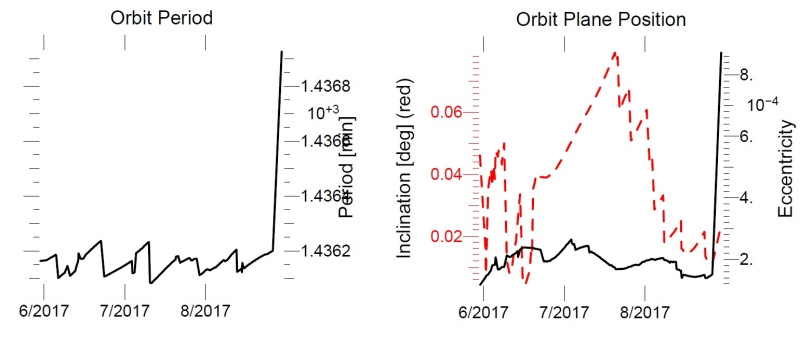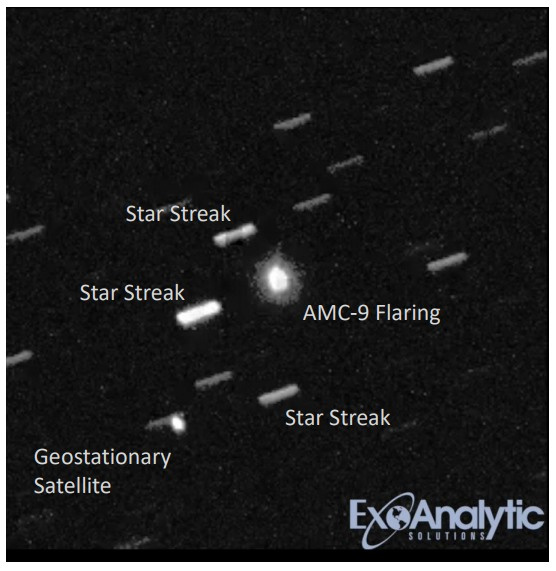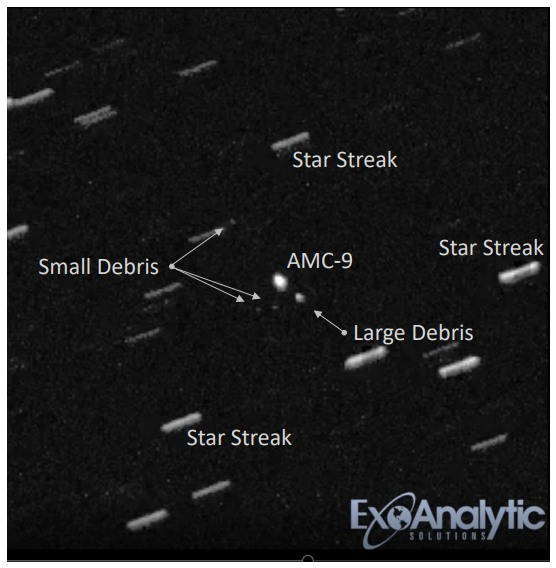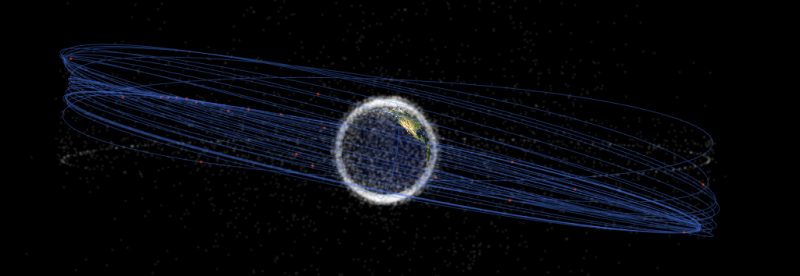New garbage in geostationary orbit: the destruction of Telcom-1 and AMC-9
On August 26, Indonesian telecom operator PT Telecom reported on an anomaly in its satellite Telkom 1. Company officials said they were expecting satellite contractor Lockheed Martin to restore contact with the satellite and transfer customers to reserve capacity as a precaution. However, the reality turned out to be worse - the network of telescopes from ExoAnalytic Solutions detected the destruction of a satellite with the release of two jets of liquid or gas and several large fragments.

In recent months, this is already the second time that a satellite has been destroyed in geostationary orbit — on June 17, communication with the AMC-9 satellite was lost, and several fragments separated from it after some time. However, it was possible to restore contact with him and even partially return to work. Geostationary orbit has long been a shortage of space, and the new trash will create more and more problems.

Telkom 1 in flight, the Lockheed Martin pattern
Telkom 1 satellite was launched in the summer of 1999 and already exceeded the estimated fifteen-year service life by three years. The development company, Lockheed Martin, believed that it could work until 2019, and the operator, PT Telecom, was going to replace the satellite with a new Telkom 4, which is scheduled to launch in 2018. Alas, on August 25, the satellite antennas lost guidance to Earth. PT Telecom quickly transferred power to other satellites, but some problems with ATMs and payment terminals in Indonesia did arise. Meanwhile, a third company, ExoAnalytic Solutions, which processes the data of 165 telescopes, has published a video on the destruction of Telkom 1.
The glowing objects running in the background are stars. The video clearly distinguishes the release of liquid or gas in two directions and at least three noticeable debris. Changing the brightness of the satellite suggests that it began to rotate. Measurements of the satellite orbit elements confirmed the fact of serious problems - the satellite, which was in its standard geostationary orbit, began to descend from it - its apocenter (highest point of the orbit) increased by 44 km, the orbit inclination increased by one hundredth degree, and now the satellite is slowly drifting westward .

Changes in orbital parameters, source: CalSky
What exactly collapsed on the satellite is impossible to know without restoring communication with it, but obviously, at least one of the tanks (fuel, oxidizer, pressurization gas) lost its integrity, tearing some elements off the structure. Telkom 1 is built on the popular A2100 platform, carrying 24 transponders in the C-band and 12 in the extended C-band. The initial mass of the satellite (with fuel) was 2765 kg.

Scheme of the A2100 platform, source: ecoruspace.me
Despite the obvious serious damage, there is a chance of re-establishing the connection. On July 17, communication with the AMC-9 satellite was lost, and a few days later, debris flying away from him were noticed, and nevertheless, on August 1, the connection with it was restored. Alas, it was not reported that it was possible to establish which elements had fallen off from the satellite.


The same company ExoAnalytic Solutions provided satellite video fragmentation.
It is very clearly seen how the satellite drifts relative to working satellites at another point of standing. In the background you can even see the open star cluster.
However, the presence of communication with the satellite AMC-9 does not mean that they can be fully managed. Usually, after the end of their service life, geostationary satellites send 200-300 km above the geostationary orbit, where they will not interfere with anyone. Alas, suddenly broken satellites remain in place and begin to drift, potentially posing a danger to other satellites. The uncontrolled satellite in geostationary orbit due to the uneven gravitational field of the Earth, the influence of the Sun and the Moon, changes its orbit so that it shifts to one of the points of stable equilibrium, and the inclination of its orbit increases to 15 °. If you look at the orbits of long-broken satellites, it is noticeable that they are tilted.

Soviet satellites Ekran, source: stuffin.space
Today, more than 440 satellites are in geostationary orbit, and there is much more debris. On the one hand, there is enough free space on it (not taking into account the points of standing, there’s just a shortage of them), and in some sense it “self-cleans”. On the other hand, this garbage does not go anywhere from the vicinity of the geostationary orbit - unlike low near-earth, here satellites can exist for millennia. Alive satellites have to track the garbage and dodge it. Kessler's syndrome, as it is shown in Gravity, is not threatened by geostationary orbit, but the question remains whether humanity can litter it before serious problems with use. However, when in the not so near future the garbage becomes too much,

In recent months, this is already the second time that a satellite has been destroyed in geostationary orbit — on June 17, communication with the AMC-9 satellite was lost, and several fragments separated from it after some time. However, it was possible to restore contact with him and even partially return to work. Geostationary orbit has long been a shortage of space, and the new trash will create more and more problems.

Telkom 1 in flight, the Lockheed Martin pattern
Telkom 1 satellite was launched in the summer of 1999 and already exceeded the estimated fifteen-year service life by three years. The development company, Lockheed Martin, believed that it could work until 2019, and the operator, PT Telecom, was going to replace the satellite with a new Telkom 4, which is scheduled to launch in 2018. Alas, on August 25, the satellite antennas lost guidance to Earth. PT Telecom quickly transferred power to other satellites, but some problems with ATMs and payment terminals in Indonesia did arise. Meanwhile, a third company, ExoAnalytic Solutions, which processes the data of 165 telescopes, has published a video on the destruction of Telkom 1.
The glowing objects running in the background are stars. The video clearly distinguishes the release of liquid or gas in two directions and at least three noticeable debris. Changing the brightness of the satellite suggests that it began to rotate. Measurements of the satellite orbit elements confirmed the fact of serious problems - the satellite, which was in its standard geostationary orbit, began to descend from it - its apocenter (highest point of the orbit) increased by 44 km, the orbit inclination increased by one hundredth degree, and now the satellite is slowly drifting westward .

Changes in orbital parameters, source: CalSky
What exactly collapsed on the satellite is impossible to know without restoring communication with it, but obviously, at least one of the tanks (fuel, oxidizer, pressurization gas) lost its integrity, tearing some elements off the structure. Telkom 1 is built on the popular A2100 platform, carrying 24 transponders in the C-band and 12 in the extended C-band. The initial mass of the satellite (with fuel) was 2765 kg.

Scheme of the A2100 platform, source: ecoruspace.me
Despite the obvious serious damage, there is a chance of re-establishing the connection. On July 17, communication with the AMC-9 satellite was lost, and a few days later, debris flying away from him were noticed, and nevertheless, on August 1, the connection with it was restored. Alas, it was not reported that it was possible to establish which elements had fallen off from the satellite.


The same company ExoAnalytic Solutions provided satellite video fragmentation.
It is very clearly seen how the satellite drifts relative to working satellites at another point of standing. In the background you can even see the open star cluster.
However, the presence of communication with the satellite AMC-9 does not mean that they can be fully managed. Usually, after the end of their service life, geostationary satellites send 200-300 km above the geostationary orbit, where they will not interfere with anyone. Alas, suddenly broken satellites remain in place and begin to drift, potentially posing a danger to other satellites. The uncontrolled satellite in geostationary orbit due to the uneven gravitational field of the Earth, the influence of the Sun and the Moon, changes its orbit so that it shifts to one of the points of stable equilibrium, and the inclination of its orbit increases to 15 °. If you look at the orbits of long-broken satellites, it is noticeable that they are tilted.

Soviet satellites Ekran, source: stuffin.space
Today, more than 440 satellites are in geostationary orbit, and there is much more debris. On the one hand, there is enough free space on it (not taking into account the points of standing, there’s just a shortage of them), and in some sense it “self-cleans”. On the other hand, this garbage does not go anywhere from the vicinity of the geostationary orbit - unlike low near-earth, here satellites can exist for millennia. Alive satellites have to track the garbage and dodge it. Kessler's syndrome, as it is shown in Gravity, is not threatened by geostationary orbit, but the question remains whether humanity can litter it before serious problems with use. However, when in the not so near future the garbage becomes too much,
